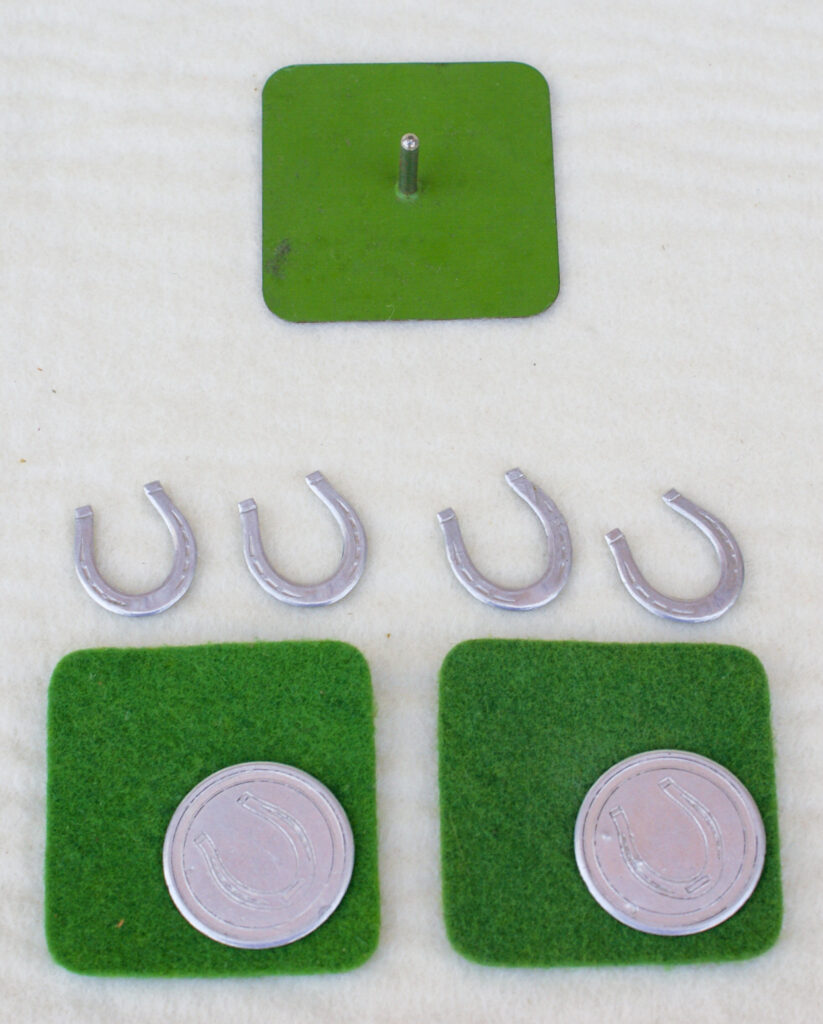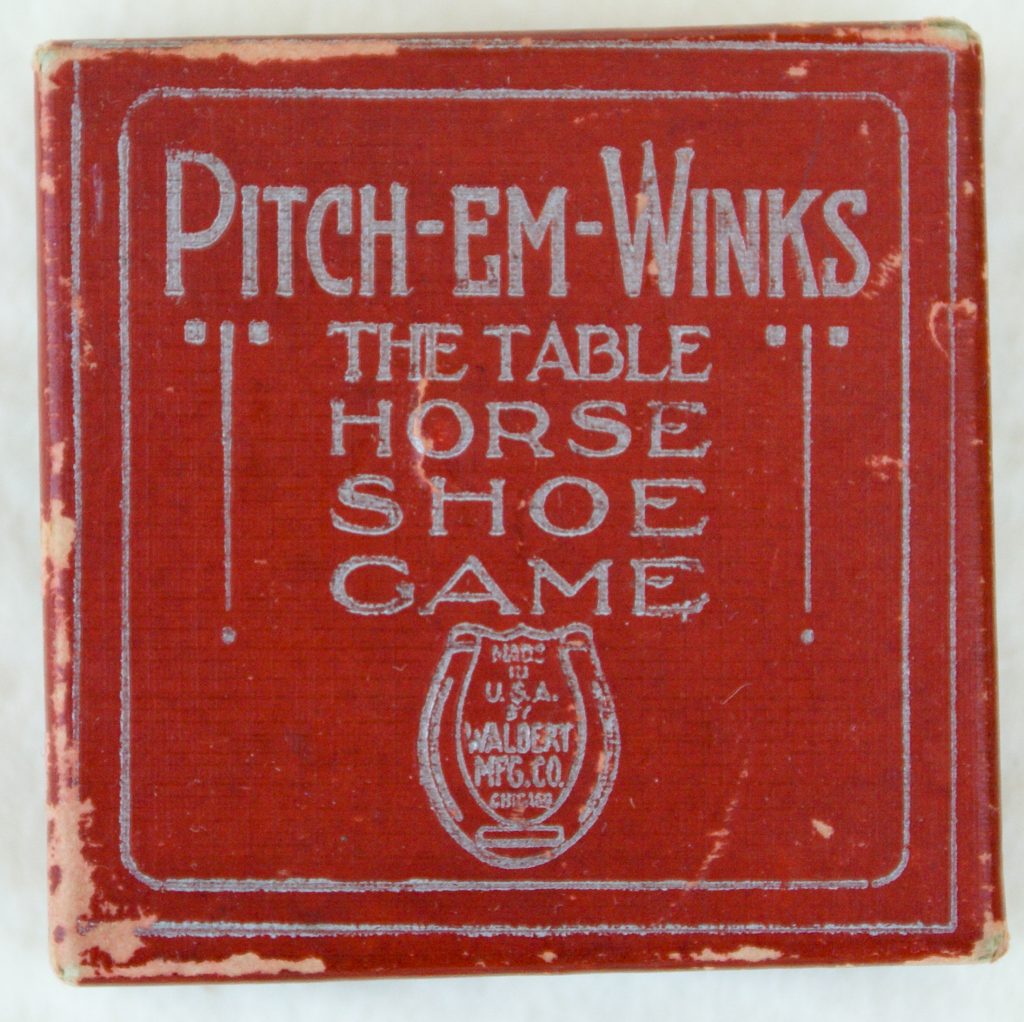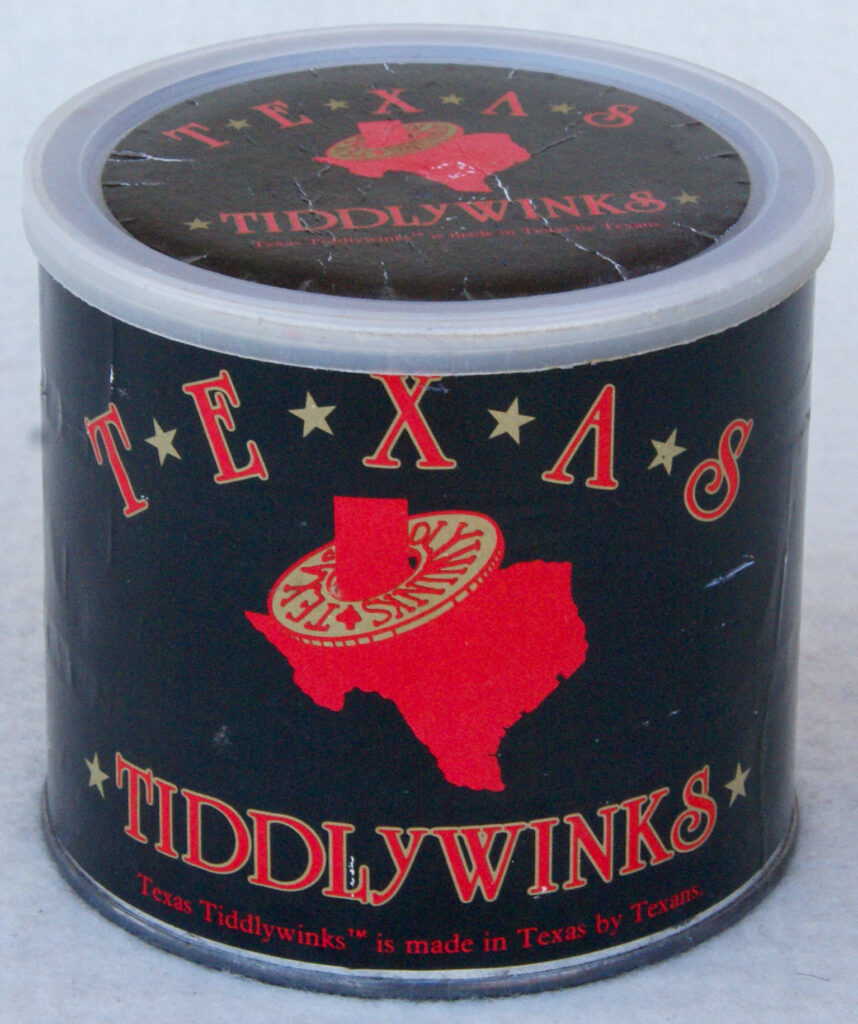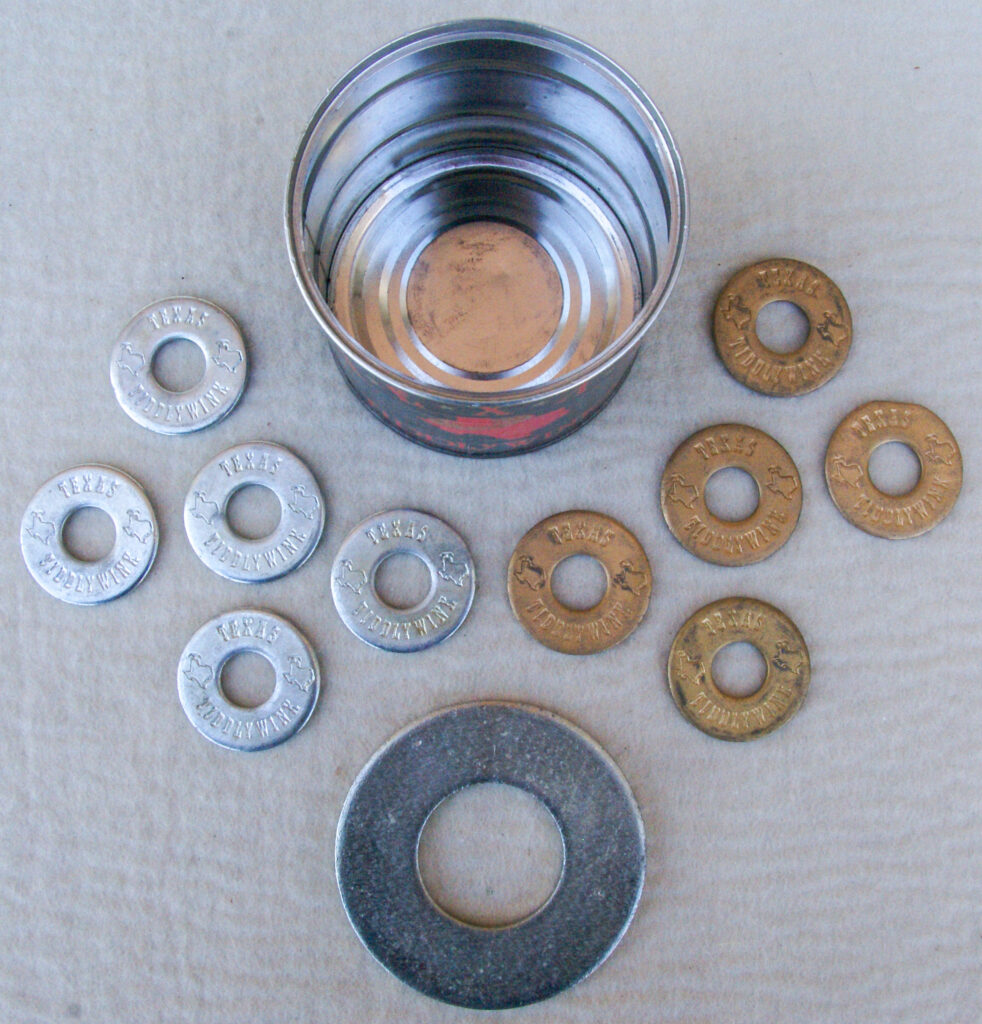Winks
A wink is the piece in a game of tiddlywinks that is flicked (by a squidger) to shoot it up in the air toward a target or other goal.
Winks are predominantly solid circular discs with rounded edges. However, particularly in the earlier days, the winks in some sets were rings (called quoits), which, amazingly enough, can be shot quite normally just like winks that are solid discs. On occasion, winks come in other shapes, for example, as horseshoes in Walbert Manufacturing’s Pitch-Em-Winks game. Winks are never spherical like marbles.

publisher • Walbert Mfg. Co.
title • · Pitch-Em-Winks the Table Horse Shoe Game
date • 1921 to 1927 at least
item · aluminum squidgers and winks, felt, target
source • Tucker Tiddlywinks Collection
photograph by • Rick Tucker
Licenseable per Creative Commons CC BY-SA 4.0
At various points in time, winks have been made of bone, ivory (rarely), clay, vegetable ivory, celluloid, various plastics, wood, and metal.
Bone winks, mostly made from cattle bone, are readily identifiable by the parallel striations on them. Bone winks were dyed a variety of colors, though some dyes, particularly yellow ones, faded over time, often making them look off-white.
While it is not exactly known how bone winks were made, bone working researcher Laura Price suggests that a crown saw may have been used. A crown saw is designed for cutting round holes.
Ivory winks, made from elephant tusks and sea mammal tusks, are quite rare.
Clay winks were formed by molds into which wet colored clays were pressed and then dried. Clay winks are quite prone to breaking, and often exhibit sharp outer edges rather than fully rounded edges due to having been produced using molds. Clay winks were likely used in the cheaper editions of a particular tiddlywinks game.
Vegetable ivory is a material derived from palm tree nuts used in game pieces; it isn’t at all related to ivory made from tusks. Vegetable ivory was used as a cheaper and more adaptable resource for game pieces than bone and ivory. Vegetable ivory winks tend to be much shinier than bone winks, and don’t exhibit bone striations. Some vegetable ivory winks exhibit some warping that makes them slightly convex on one side and concave on the other. These winks are quite durable.
Celluloid winks, also referred to as Ivorine or French Ivory, though they were not made of mammal ivory, were made from an early plastic mixture of nitrocellulose and other materials. Celluloid is rarely used nowadays except, most prominently, for Ping-Pong balls.
In the 1950s through 1970s, quality plastic winks were made by slicing discs off colored polystyrene rods, and then tumbling them in a jeweler’s or rock tumbler to round the edges and buff the faces of the winks. The Walmsleys company in England was a prominent manufacturer of these quality winks, and sold them to a variety of British game manufacturing companies for use as winks or game counters in their games.
Starting in the 1950s or thereabouts, low quality winks were cheaply made via injection molding of sheets (as often found in plastic model assembly kits) containing a multitude of plastic winks each of which were attached to an overall molded sheet by a thin plastic connector, and therefore each wink had to be torn or bent off the overall sheet, thereby leaving a telltale burr sticking off the edge; these winks also often have a sharper edge rather than a rounded one.
Wooden winks are not at all common, but have been used, notably in a very small number of French tiddlywinks games, even modern ones. Wooden winks are prone to breaking when used.
Metal winks are quite uncommon. Walbert Manufacturing’s Pitch-Em-Winks game includes aluminum winks in the shape of horseshoes. The game Texas Tiddlywinks, made by a company called Texas Tiddlywinks, © 1986, made a tiddlywinks game that uses steel washers (with a hole in them, as they were intended to have screws through them) as the winks.
The modern, official game of tiddlywinks (since its founding by the Cambridge University Tiddlywinks Club in 1955 and the establishment of the first official rules in 1958), calls for two large winks (7/8 inch in diameter) of each of the four colors (blue, green, red, and yellow), and four small winks (5/8 inch in diameter) of the same colors (though now officially adopting metric measurements of the same).
- Materials Used in Games, from the AGPI Archives Game Catalog
Squidgers
A squidger is a shooting instrument that is held by a winker to flick a wink to cause it to jump up in the air toward an intended target.
In many tiddlywinks sets from 1888 to the present day, the squidgers were simply the larger discs that came with a game. In many of the earlier sets, the squidgers were 7/8 inch in diameter. The smaller discs in most of these games were the winks (often 5/8 inch in diameter). The sizes do, of course, vary.
In the modern, official game of tiddlywinks (since its founding by the Cambridge University Tiddlywinks Club in 1955 and the establishment of the first official rules in 1958), squidgers must be between 1 inch and 2 inches in diameter (and now, the metric equivalents, with a limit on their thickness).
Shooting Surfaces
To shoot a wink, a winker uses a squidger to apply pressure staring on the top of the wink and then quickly flicks the squidger across the top, while maintaining downward pressure, and over the edge of the wink. The wink should then sail up in the air in an arc in the direction in which it was shot, and then fall down. Without a cushiony surface to shoot the wink from, the wink will just snap on a hard surface and move horizontally rather than leaping into the air in an arc. Therefore, resilient surfaces such as thick tablecloths, blankets, and felt are needed to play tiddlywinks properly.
Shooting surfaces in the early McLoughlin era were made of sewn flannel and felt; and shortly thereafter, of large felt playing surfaces (Hop Scotch, naval simulation, Grasshopper Tennis, etc.). Later, the shooting pads were small felt pieces of medium thickness, and starting in the 1960s or 1970s, the generic and ultracheap sets have had no felt or hard, thin felt.
Targets
A bevy of targets has been used in tiddlywinks games.


